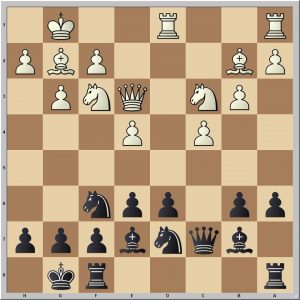
What is the Hedgehog?
The Hedgehog is not a specific opening, but a middlegame structure such as the isolated queen’s pawn (IQP). Hedgehog positions can arise across numerous openings, so that knowledge of the Hedgehog significantly expands your own scope. The diagram above shows an example from the English Opening. You can see the typical features: 1. exchange of the black c-pawn for the White’s d-pawn 2. a white pawn on c4 (a white pawn on e4 is optional) 3. no black pawn on the 5th rank in the opening phase.
The black winning potential
At first glance, the hedgehog doesn’t look like much. The black position in the diagram looks like a kind of fortress or draw weapon. However, it is rather an attempt to play for a win with Black. The following features suggest this:
1. Asymmetrical structure
There are virtually no symmetry structures in the hedgehog. It is therefore difficult for White to play destructively for a draw.
2. Pawn majority in the center
If the white c-pawn has disappeared (after …b6-b5), the way is clear for …d6-d5.
3. Better king safety
White’s king position is already loosened up in the diagram. This is exacerbated when White follows with f2-f4.
4. Enormous lever potential
The advance …b6-b5 is the most important pawn break, but by no means the only one. In the Hedgehog ALL pawns can actually be used as levers
Metagame qualities
The Hedgehog also harbors a number of advantages that are not or only indirectly related to the actual position on the board.
1. Competitive advantage
Since the structure is complicated and the visual impression is sometimes deceptive, it places high demands on the protagonists. This offers more opportunities for a competitive advantage than a simple structure would do. Since we as black players are more likely to be the experts than our opponent, this circumstance plays into our hands.
2. Psycho weapon
As a counter-opening, the Hedgehog allows Black to lie in wait. In an equal position, White could now feel obliged to prove an opening advantage and therefore overplay. But even if White has no particularly aggressive intentions, he can be made to harm himself. The Hedgehog structure allows Black to maneuver to his heart’s content, to provoke or to make small pinpricks at his opponent. It is often difficult for the white player to keep still in the long term. At some point, many lose their composure and weaken their pawn structure.
3. Efficiency
The Hedgehog player is able to simply entrench himself behind his hedgehog structure in a variety of different openings, starting with the English Opening and various Sicilians, through the Nimzo-Indian and Queen’s Indian, to the Bogo-Indian or King’s Indian. Thanks to this universal character, the Hedgehog saves its user countless hours of work in building up the opening repertoire. Since it is more about general plans, you can often get by without concrete theoretical knowledge.
Content of the seminar
The focus is on the aggressive options of the Hedgehog player, i.e. the black pawn levers. It starts with the three most important (…b6-b5, …d6-d5, …e6-e5) and ends with the rest (…f7-f5, …g7-g5 and …h7-h5).